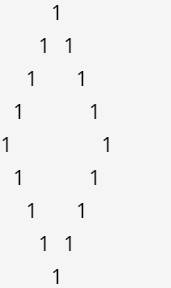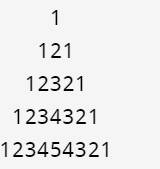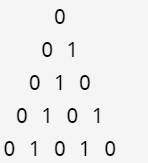Number Pattern Programs in Java
Pattern programs in Java are a type of problem that use nested loops to produce different patterns of numbers, stars (*), or other characters. In this blog we will dive deeper specifically into number pattern programs in java.
Number pattern programs in Java display a sequence of numbers in certain patterns. These programs are often used as a practical exercise for learning loop control structures in Java (i.e., for loops, while loops, and do-while loops). The patterns could be anything from a simple pyramid shape to more complex combinations and sequences of numbers.
Why Are Number Pattern Programs Important?
- Understanding Control Structures: Helps understanding and mastering the use of loops and control structures.
- Problem-Solving Skills: Enhances logical thinking and problem-solving skills.
- Attention to Detail: Improves attention to detail by focusing on precise pattern generation.
- Preparation for Interviews: Commonly used in coding interviews and assessments.



Best-suited Java courses for you
Learn Java with these high-rated online courses
Basic Approach to Solve a Number Pattern Program Using an Example
Step 1: Understand the Pattern
- Visualize the Pattern: Observe the pattern to understand its structure.
- Identify the Number of Rows and Columns: Determine the number of rows and columns in the pattern.
- Analyze the Sequence: Understand how the numbers are arranged in each row and column.
Example Pattern
Step 2: Initialize the Program
Start the Class and Main Method: Initialize your Java program with a class and a main method.
public class Main { public static void main(String[] args) { // Code goes here }}
Step 3: Determine and Set the Number of Rows
Set the Number of Rows: Determine how many rows the pattern will have.
int n = 4; // The pattern has 4 rows
Step 4: Construct an Outer Loop for Rows
Create the Outer Loop: Set up an outer loop to iterate through the rows.
for (int i = 1; i <= n; i++) { // Inner loops will go here}
Step 5: Construct Inner Loops for Columns
Create Inner Loops for Columns: Utilize inner loops to manage the columns and print the numbers.
for (int j = n; j >= 1; j--) { if (j <= i) { System.out.print(j); } else { System.out.print(" "); }}for (int k = 2; k <= i; k++) { System.out.print(k);}
Step 6: Combine and Execute the Code
Combine All Code Segments: Combine all parts and run the program to print the pattern.
public class Main { public static void main(String[] args) { int n = 4; for (int i = 1; i <= n; i++) { for (int j = n; j >= 1; j--) { if (j <= i) { System.out.print(j); } else { System.out.print(" "); } } for (int k = 2; k <= i; k++) { System.out.print(k); } System.out.println(); } }}
Following the above steps, you can systematically approach and solve any number pattern program in Java.
Top 10 Number Pattern Programs in Java
- Right-Angle Triangle Pattern
- Inverted Right-Angle Triangle Pattern
- Pyramid Number Pattern
- Inverted Pyramid Number Pattern
- Diamond Number Pattern
- Hollow Diamond Number Pattern
- Pascal’s Triangle Pattern
- Floyd’s Triangle Pattern
- Palindromic Number Pattern
- Binary Number Pyramid Pattern
Let’s understand each of these one by one in detail:
Right-Angle Triangle Pattern: A simple pattern where each row contains increasing consecutive numbers.
Code
public class Main { public static void main(String[] args) { for (int i = 1; i <= 5; i++) { for (int j = 1; j <= i; j++) { System.out.print(j + " "); } System.out.println(); } }}
Inverted Right-Angle Triangle Pattern: Similar to the right-angle triangle pattern but inverted.
Code
public class Main{ public static void main(String[] args) { for (int i = 5; i >= 1; i--) { for (int j = 1; j <= i; j++) { System.out.print(j + " "); } System.out.println(); } }}
Pyramid Number Pattern: A pattern of numbers arranged in the form of a pyramid.
Code
public class Main { public static void main(String[] args) { int n = 5; for (int i = 0; i < n; i++) { for (int j = 0; j < n - i; j++) { System.out.print(" "); } for (int k = 0; k <= i; k++) { System.out.print(k + 1); } for (int l = i - 1; l >= 0; l--) { System.out.print(l + 1); } System.out.println(); } }}
Inverted Pyramid Number Pattern: An inverted version of the pyramid number pattern.
Code
public class Main { public static void main(String[] args) { int n = 5; for (int i = n; i >= 1; i--) { for (int j = n; j > i; j--) { System.out.print(" "); } for (int k = 1; k < (i * 2); k++) { System.out.print(k); } System.out.println(); } }}
Diamond Number Pattern: A pattern where numbers are arranged in a diamond shape.
Code
public class Main { public static void main(String[] args) { int n = 5; for (int i = 1; i <= n; i++) { for (int j = i; j < n; j++) { System.out.print(" "); } for (int k = 1; k < (i * 2); k++) { System.out.print(k); } System.out.println(); } for (int i = n - 1; i >= 1; i--) { for (int j = n; j > i; j--) { System.out.print(" "); } for (int k = 1; k < (i * 2); k++) { System.out.print(k); } System.out.println(); } }}
Hollow Diamond Number Pattern: A diamond-shaped pattern with numbers on the border and hollow inside.
Code
public class Main { public static void main(String[] args) { int n = 5; for (int i = 1; i <= n; i++) { for (int j = i; j < n; j++) { System.out.print(" "); } for (int k = 1; k <= (2 * i - 1); k++) { if (k == 1 || k == (2 * i - 1)) { System.out.print(1); } else { System.out.print(" "); } } System.out.println(); } for (int i = n - 1; i >= 1; i--) { for (int j = n; j > i; j--) { System.out.print(" "); } for (int k = 1; k <= (2 * i - 1); k++) { if (k == 1 || k == (2 * i - 1)) { System.out.print(1); } else { System.out.print(" "); } } System.out.println(); } }}
Pascal’s Triangle Pattern: A triangular pattern where each number is the sum of the two numbers directly above it.
Code
public class Main { public static void main(String[] args) { int n = 5; for (int i = 0; i < n; i++) { int number = 1; for (int j = 0; j < n - i; j++) { System.out.print(" "); } for (int k = 0; k <= i; k++) { System.out.print(number + " "); number = number * (i - k) / (k + 1); } System.out.println(); } }}
Floyd’s Triangle Pattern: A right-angle triangle pattern with consecutive numbers.
Code
public class Main { public static void main(String[] args) { int n = 4, number = 1; for (int i = 1; i <= n; i++) { for (int j = 1; j <= i; j++) { System.out.print(number + " "); number++; } System.out.println(); } }}
Palindromic Number Pattern: A pattern where numbers are the same in a row forwards and backward.
Code
public class Main { public static void main(String[] args) { int n = 5; for (int i = 1; i <= n; i++) { for (int j = i; j < n; j++) { System.out.print(" "); } for (int k = 1; k < i; k++) { System.out.print(k); } for (int l = i; l >= 1; l--) { System.out.print(l); } System.out.println(); } }}
Binary Number Pyramid Pattern: A pyramid pattern of binary numbers (0 and 1).
Code
public class Main { public static void main(String[] args) { int n = 5; for (int i = 0; i < n; i++) { for (int j = n - 1; j > i; j--) { System.out.print(" "); } for (int k = 0; k <= i; k++) { System.out.print((k % 2) + " "); } System.out.println(); } }}
Thus, number pattern programs in Java are an essential part of foundational programming learning and practice. They not only help in understanding the use and manipulation of loops and control statements, but also enhance logical thinking and problem-solving skills.
FAQs
What are number pattern programs in Java?
Number pattern programs are Java exercises that involve printing sequences of numbers in specific arrangements or shapes. These patterns can include sequences like pyramids, triangles, or other geometric arrangements, aimed at practicing loops and control structures in Java.
Why are number pattern programs important for Java beginners?
Number pattern programs help beginners understand and master the use of nested loops, conditional statements, and control flow mechanisms in Java. They are excellent for practicing logical thinking and problem-solving skills.
Can number pattern programs in Java involve non-integer numbers?
While most number pattern programs focus on integers for simplicity and clarity, they can indeed be adapted to use non-integer numbers (like floating-point numbers) to demonstrate more complex patterns or mathematical concepts.
What is a simple example of a number pattern program in Java?
A simple example is a program that prints a straight line of numbers from 1 to 5. It involves using a for-loop to iterate through each number and print it out on the same line.
How can one customize number pattern programs in Java?
Customization can include altering the range of numbers used, changing the direction of the pattern (e.g., from ascending to descending), or incorporating additional Java features like methods to create more complex and dynamic patterns. Creativity and understanding of Java's control structures are key to customization.














Comments
(3)
J
2 months ago
Report
Reply to Jeyapandi Pitchai mani
s
9 months ago
Report
Reply to surya s b
p
a year ago
Report
Reply to pavan kumar v